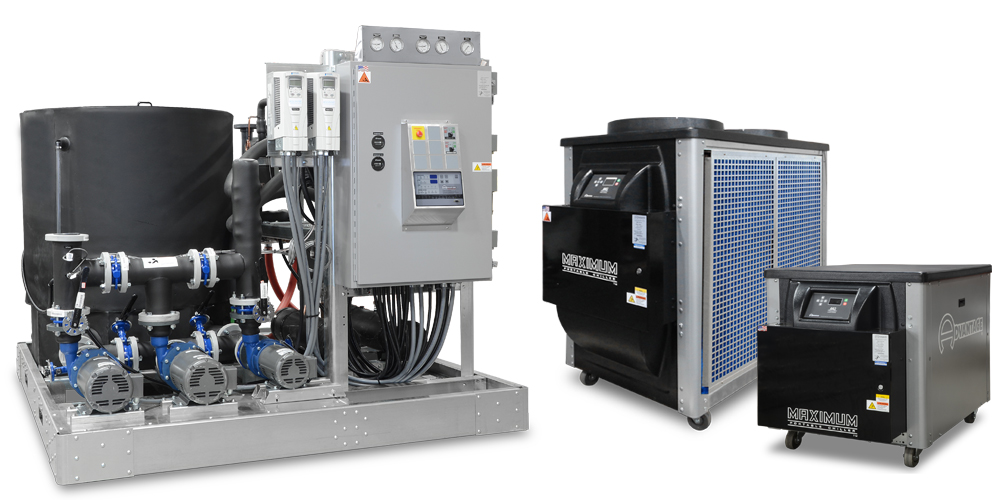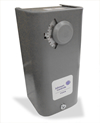A water chiller typically operates with a set point of 50°F or higher. However, if setpoints between 20°F - 48°F are required, special precautions must be taken to prevent freezing and possible damage.
Attention must be given to freeze protection, water supply and pressure switch limit adjustments.

Shown above is a Titan central chiller (left) and Maximum Series Portable Water Chillers (right).
A. FREEZE PROTECTION
- It is understood that untreated water freezes at 32°F. The refrigerant in the chiller's evaporator must be 10°F or more colder than the desired fluid set point
to create heat transfer. Advantage recommends a fluid temperature lower limit of 48°F for straight water. Below 48° a water and inhibited prophylene glycol mixture is recommended to
lower the fluid freeze point. Limiting the lower set point for straight water to 48°F allows for a small buffer between the operating evaporating temperature and the fluid freez point
minimizing the risk of freezing the evaporator. Evaporator freezing can casue it to fail and result in extensive damage to the chiller.
- Therefore, an inhibited propylene glycol and water soltuion must be used in lieu of straight water for set points below 48°F. Prescribed amounts are listed in the chart on this page.
While the inhibited glycol percentages listed may provide freeze protection well below the minimum protection level required the percentages listed are the minimum recommended by most fluid
manufacturers for the included scale and corrosion inhibitors to work properly.
- On initial installation of the unit, the water/glycol solution should be premixed, then added to the reservoir. After the pump has been started, water lines filled and air purged, it may be necessary to add more water/glycol solution to maintain the recommended reservoir level.
- Note. A refractometer, such as Misco 7084VP should be used on a regular basis to determine the mixture strength
according to freeze point. The freeze point temperature should be 25°F below the lowest required set point. Water will evaporate from the mixture and if you continue to add a premixed solution
eventually you have too much glycol. It is necessary to add water or glycol to maintain proper freeze point temperature.
- Please Note : Automotive type antifreeze must not be used in your Advantage chiller.
- Automotive type antifreeze contain silicates that adhere to heat transfer surfaces of the system preventing maximum heat transfer. Also, higher than required
ratios of inhibited propylene glycol to water inhibits effective heat transfer. See the chart on below and the chiller's operating manual for specific details.
B. WATER SUPPLY
- The automatic water supply (if equipped) restores the reservoir water level as needed. However, if untreated water is added to a water/glycol solution, dilution will
occur decreasing the freeze protecting ability of the soltuion.
- Therefore, the water supply source must be disconnected and the connection capped. The operator must monitor the water/glycol level and manually make-up maintain proper reservoir level.
C. LIMIT SWITCH ADJUSTMENTS
- To ensure safe and efficient operations at lower set points, adjustments of the freezestat (where equipped) and low pressure switch factory settings are required.
The chart on this page lists the appropriate settings.
- The low pressure switch serves as the main defense against freezing and to protect the compressor from adverse suction pressures. Suction pressures derease with lower
operating setpoints. To prevent freezing and short cycling the compressor, the low pressure switch must be adjusted to accomodate the lower setpoint. Units may be equipped and an adjustable
low pressure switch (figure A) or a non adjustable "fixed" low pressure switch (figure B). For units with adjustable pressure switches (figure A) adjustments to the low pressure switch are
moade by rotating the adjusting screw on top of the control and observing the movement of the pointers in the control window until the prescribed setting is determined.
- For units with non-adjustable "fixed" pressure switches, the low pressure switch (figure B) must be replaced with a switch with the appropriate lower range. A certificed
refrigeration technican must make this change.
- Some units are equipped with a freezestat (figure C). For mechanical freezestats, adjustments are made by removing the cover and rotating the selector dial with a
screwdriver. Electronic freezestats are adjusted through the setup parameters via the instrument control panel (consult the operating manual for details).

Fig. A
Adjustable low pressure switch

Fig. B
Fixed low pressure switch

Fig. C
Freezestat
D. PRECAUTIONS
- At any set point, the possibilitly of freezing exists and it is the operator's responsibility to take necessary action to prevent freezing at all times.
- The Advantage warranty does not cover damages caused by freezing.
E. CHARTS
Operating Temperatures
48°F - 70°F
25°F - 47°F
10°F - 24°F
Freeze Point of Fluid
32°F
10°F
-5°F
Freezestat Setting
38°F
15°F
5°F
Cut-Out Temperature
32°F
10°F
-5°F
Cut-In Temperature
36°F - 39°F
15°F - 18°F
0°F - 7°F
Low Pressure Switch Settings (by refrigerant type)
R22
Cut-Out
58#
33#
20#
Cut-In
63#
38#
25#
R134A
Cut-Out
28#
12#
4#
Cut-In
33#
17#
9#
R410A
Cut-Out
102#
63#
43#
Cut-In
111#
72#
52#
R404A
Cut-Out
72#
44#
29#
Cut-In
79#
49#
34#
R407C
Cut-Out
52#
28#
16#
Cut-In
58#
34#
22#





